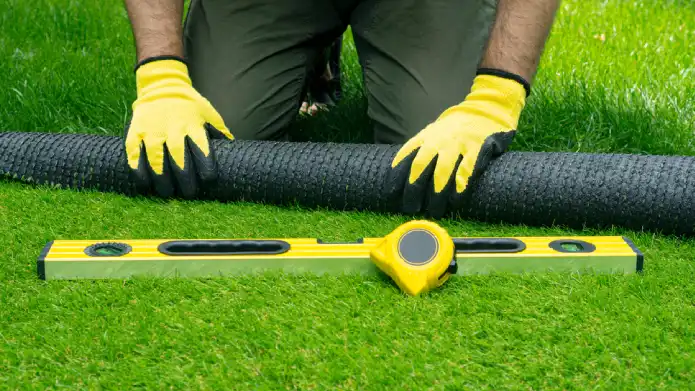The use of artificial grass in gardening and landscaping projects has often divided opinion. From the misconception that it harms the environment, several myths have been spread far and wide, leaving many people with false beliefs.
So, in a world where biodiversity takes precedence over and above convenience, is there really a place for artificial grass, and if so, how can we weigh up its advantages against the many arguments against its use?
With this article, we will demystify these misconceptions and provide factual evidence to clear any misinformation surrounding artificial grass. So, sit back and discover the truth about artificial grass.
Artificial Grass Installation: Myths that Need to be Dispelled

Artificial grass has rapidly gained popularity as a versatile and eco-friendly alternative to natural lawns. Yet, along with its growing fame, many myths and misconceptions have sprung up, such as:
- Am I simply covering my garden with plastic
- Artificial grass is environmentally unfriendly
- Artificial grass is a replacement for natural grass
- Artificial grass is maintenance-free
- Artificial grass destroys biodiversity
Let’s clarify these misconceptions:
Myth 1: Am I Simply Covering My Garden With Plastic
A large degree of somewhat catastrophic language has been used in the mainstream press around large areas of the country being ‘covered in plastic’. This represents a somewhat exaggerated view of any artificial grass installation carried out by a professional and reputable company.
The problem is that the media focuses on high-profile, low-cost new build-type developments that pop artificial grass over outdoor areas to look tidy and sell more houses. Chances are the product they use is a cheap alternative, which is not laid properly with the right subbase and landscaping work.
The proper approach is to consider a premium artificial grass product as an alternative to other potential materials, such as wooden decking, paving, or concrete. As part of an overall design, different finishes and materials are chosen together to enhance one another, not just as one-size-fits-all.
Myth 2: Artificial Grass is Environmentally Unfriendly
Most first-generation artificial grass products are made from different polymers, which are difficult to separate and recycle. However, as with every industry that uses plastic, there has been a lot of research and development to make products that can be recycled.
Remember that a premium grass product has a long life, usually between ten to 20 years, depending on where the grass is fitted and how much traffic and use it sustains. A premium product is exceptionally durable and can withstand substantial wear and tear.
Myth 3: Artificial Grass is a Replacement for Natural Grass
If you have a beautiful, green, lush lawn, why on earth would you want to replace it? However, if parts of your garden are on a slope that is constantly dry and drained of water, under a tree, blocking out any sun, or in awkward and hard-to-reach areas, these can be problematic.
Natural grass struggles to grow in these areas, and there is no reason why you shouldn’t replace it with artificial grass. Not only will this alleviate looking after hard-to-reach areas, but it’ll also make the area look better, replacing dry, yellow, dusty patches with lush greenery.
Myth 4: Artificial Grass is Maintenance-Free
While artificial grass is often lauded as maintenance-free, it isn’t. True, you won’t need to spend hours and hours mowing it every weekend during the summer months.
However, it needs to be hosed down and brushed down now and again to restore the fibers and remove any dust and debris. But the maintenance takes minutes, not hours.
Myth 5: Artificial Grass Destroys Biodiversity
Planned carefully, artificial grass can solve awkward areas of garden design, leaving the balance of the space to be adapted to encourage and improve overall biodiversity.
Choosing to lay down artificial grass is never an ‘either-or’ strategy for an outside space. Simply put in the right circumstances, it forms part of an overall garden design that balances out aesthetics, maintenance, and environmental issues. It has its place.
How much does it cost to install artificial grass?

Depending on the size and shape of your yard, you may expect to pay anywhere from $5.50 to $19.50 per square foot. The average cost of installing an artificial lawn ranges from around $2,970 to $7,100.
While the cost might seem steep, remember that artificial grass requires little maintenance and is incredibly long-lasting. Plus, it can add value to your home in the long run.
What is the cheapest way to lay artificial grass?
Artificial grass can be laid and installed using nails, a cheaper alternative. While it might not be the most secure seaming method, nails can get the job done and save money.
Remember that nails can work loose over time, especially with heavy foot traffic. Consider whether your artificial grass installation will have a lot of use before relying on this method. But for those willing to take a chance, nails can be the cheapest method of laying artificial grass.
Can I install artificial grass myself?
Indeed, you can. It’s a great way to save money and enjoy a low-maintenance garden all year round. However, before diving in, weigh up the labor and effort involved. While DIY may require more elbow grease, you stand to reap the benefits of cost savings and a stunning lawn.
How long does artificial grass last for?
Although the lifespan of artificial grass can vary based on factors such as quality and maintenance, you can generally expect it to last for a minimum of 8-10 years. But, if you invest in high-quality grass and take a little time for routine upkeep, such as raking and rinsing, your artificial grass can last 15 to 20 years.
Can I install artificial grass on the dirt?
You can install your artificial grass on the soil or dirt, but a few steps are involved. You’ll need to clear the surface of any debris and obstacles that could impact the durability of your new turf. Afterward, you will be able to proceed with the installation procedure.
Demystifying the Myths: Clear Up Misconceptions and Knoe the Truth About Artificial Grass
There are indeed many misconceptions surrounding the use of artificial grass. But we have debunked the false beliefs surrounding using artificial grass and provided factual information that defies any preconceptions.
Even though it is true that some low-quality varieties may be less environmentally friendly than others, modern synthetic turf has many sustainable options that can reduce its impact.
However, this isn’t meant to replace natural grass but to provide an alternative for places where real grass can’t grow sufficiently. So, don’t let the misconceptions confuse you. Instead, embrace the benefits of this fantastic garden trend.